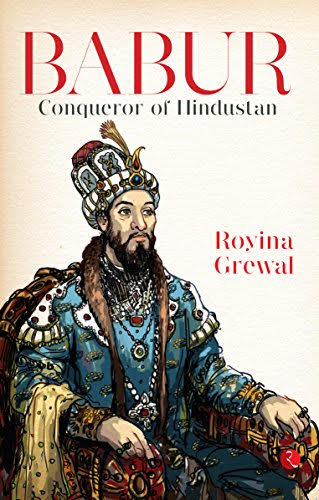"Babur" by Royina Grewal.

Above: "Babur." Royina Grewal. 421 Pages.
Like other Islamic rulers during the Golden Age of Islam, the Moghuls were enlightened leaders.
I completed reading this book today.
"Babur" is a historical novel. Babur was the founder and first Emperor of the Mughal dynasty in India. He was a patrilineal great grandson of Emperor Tamerlane, who was, in turn, a direct descendent of Genghis Khan.
After limited success in retaining possession of his "home turf," including gaining, then losing, then regaining possession, then losing again, possession of Samarkand, Babur turned his attention to India. At that time, the Indo-Gangetic Plain (Hindustan) of northern India was ruled by Ibrahim Lodi of the Afghan Lodi dynasty, whereas Rajputna, to the west, was ruled by a Hindu Rajput Confederacy, led by Rana Sanga of Mewar. Babur defeated Ibrahim Lodi at the First Battle of Panipat in 1526 AD, and founded the Mughal empire. After Panipat Babur faced opposition from the Rajput rulers and eventually subjugated them, turning them into tribute paying vassals.
It is at the battle of Panipat that the historical novel begins. The novel narrative ends in 1530 at Babur's death, at the ripe old age of forty-seven. Babur's son, Humayan, succeeded Babur as the second Mughul emperor.
I have spent over three years of my life in greater "Hindustan," working in Delhi and Calcutta as a young banker in the early '70's and travelling regularly in the area up to the present day. I've seen most of the great Mughal monuments: The Red Forts in Delhi and Agra. The Taj Mahal, Agra. Humayan's Tomb, Delhi. Fathepur Sikri, Uttar Pradesh. And, Jama Masjid, Delhi. I have also seen many of the great Rajput forts in Rajesthan, including Amber Fort, Jaipur and Kumbhalgarh Fort, Rajesthan.
During the course of my sightseeing I learned the basic historical outlines of the Mughal empire. But, my understanding of Mogul history was abstract, "black and white"... perfunctory. That's why I enjoyed reading Royina Grewal's "Babur," so much. "Babur" is an exciting narrative about the life of Babur... a narrative that author Grewal touts in the novel's afterward as a "rattling good read." And its true. Heretofore abstract, black and white historical figures are brought to life in living color in "Babur."
In "Babur" we learn of Babur's military genius. He wins the battle of Panipat with the first use, in Hindustan, of canon. His clever military strategy, driving the Lodi troops into the face of the cannonade while blocking an escape route, enables Babur to win the battle with half the number of soldiers as were sent into battle by the enemy.
Grewal's insightful descriptions of Babur as a leader, who showed compassion on the one hand but also ruthlessness on the other, attest to her deep insight on the nuances of leadership.
We see Babur preparing his son Humayan, to lead. All of the foibles of youth are seen in Humayan's progress to understand how to lead... impetuousness, disobedience, arrogance and hot headedness. Yet, at the time of Babar's passing at age 47, Humayan, still in his twenties, is ready to assume leadership in the four year old empire thanks to the training of his insightful father.
Royina Grewal plans a trilogy, where, in the second novel we'll learn how Humayan handled his new found leadership responsibilities.
Babur deals with palace intrigue. Babur's extended "family" includes three wives, four sons, two long term friends from his Kabul upbringing, and their wives, children and concubines not to mention a coterie of generals and artillery masters.
Some of these family members and hangers on do not have Babur's interests at heart. Some scheme to oust him from power. One close associate deviously cuckholds Babur by consorting with one of his wives as he schemes with Babur's enemies to undermine Babur's hold on Hindustan. There are spies, secret midnight assignations... everything necessary to create a fast paced adventure story.
There are some marvelous, vivid descriptions of the hunt... including a tiger hunt where Babar and his mahoot fall from a tiger-spooked elephant creating a situation where Babur must face a charging tiger from a position on the ground.
Grewal does not shy away from evocative, yet not explicit, descriptions of intimacy between Babur and his wives.
The book is written in the present tense.
The next time I contemplate Humayan's tomb in Delhi, or another Mughal monument, I now, thanks to having read "Babur," will have more than an abstract knowledge of historical events leading to its creation. I will have a living color, vivid sense of real people, living at a different time, who created a great, even if short lived, empire.
Like other Islamic rulers during the Golden Age of Islam, the Moghuls were enlightened leaders. Over three centuries the Moghul's built a great empire, characterized by growth in knowledge, art, architecture. Along with quantum growth in knowledge, the Moghuls were able to ensure harmony religious freedom amongst a diverse population.
I look forward to Rowena Grewal's next "living color" novels on the Moghuls.
Royina Grewal is a personal friend. She lives in New Delhi, India.